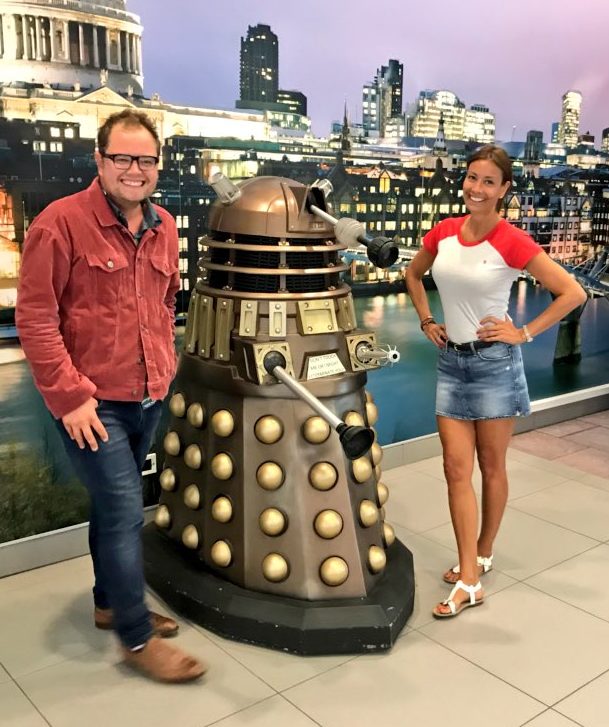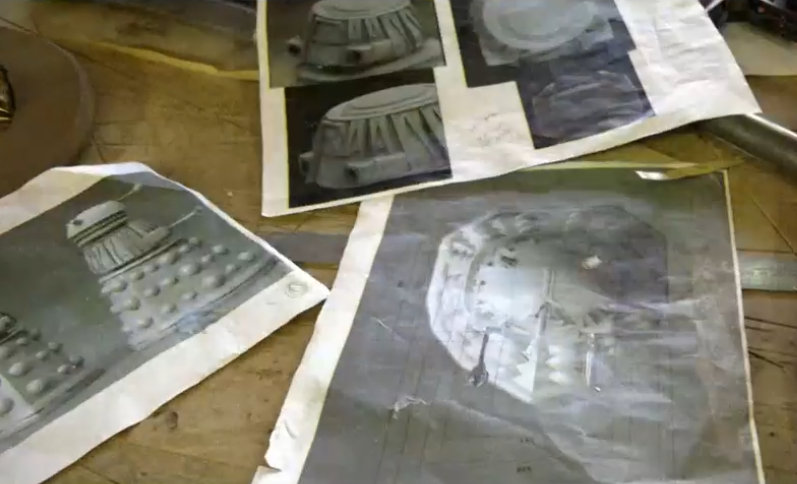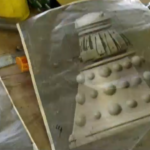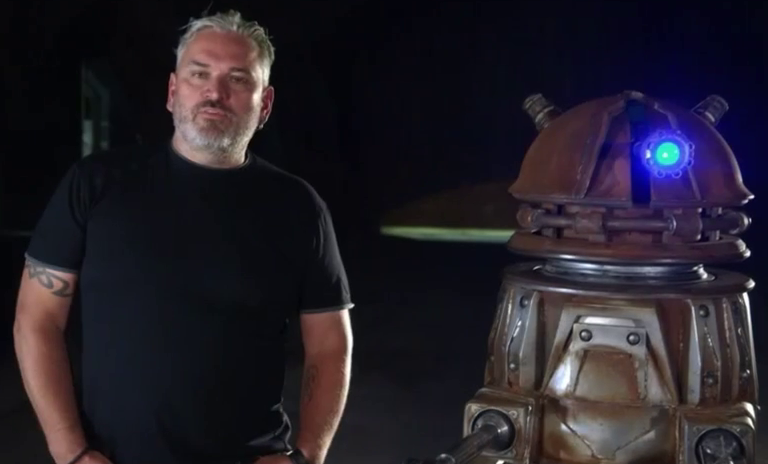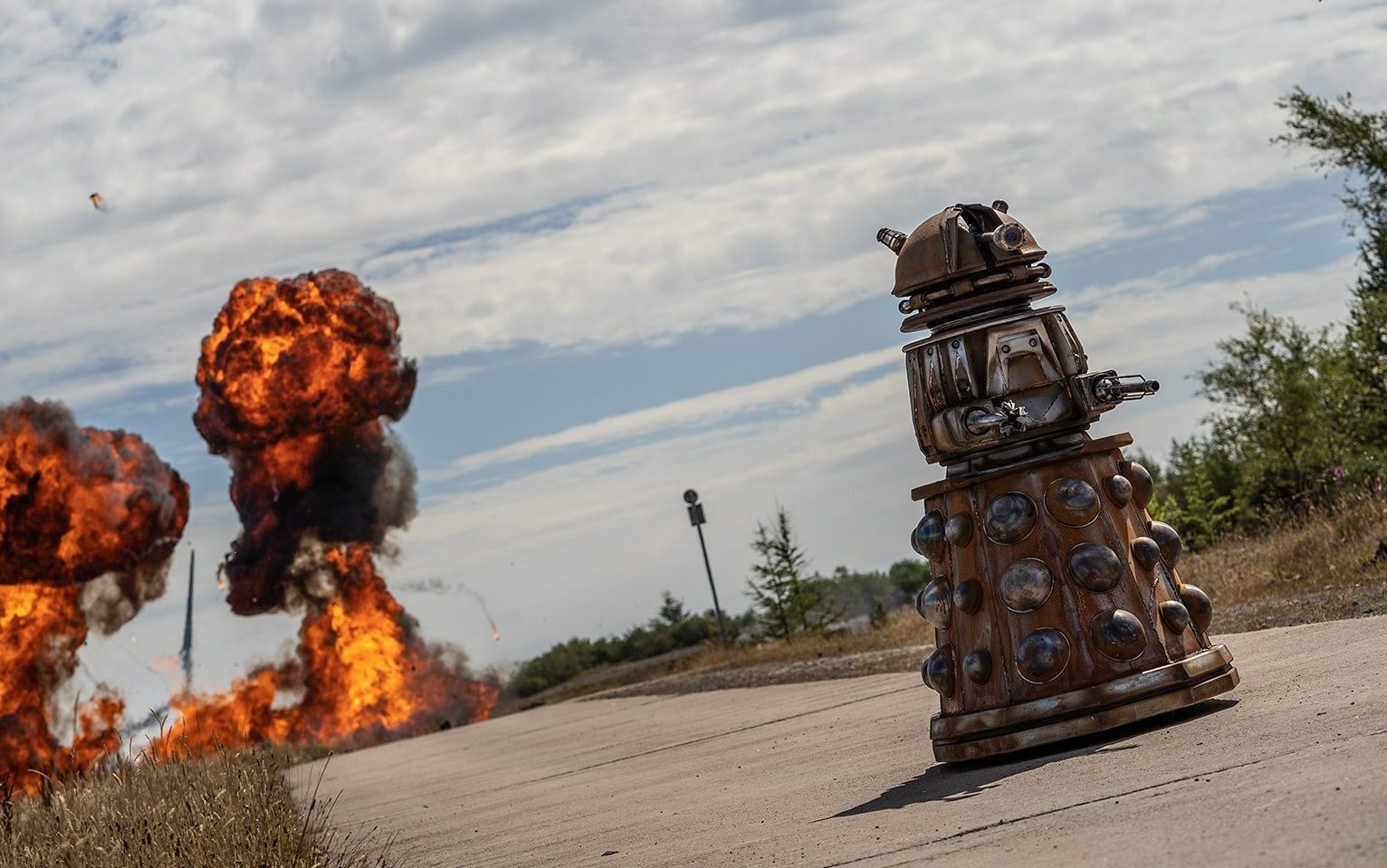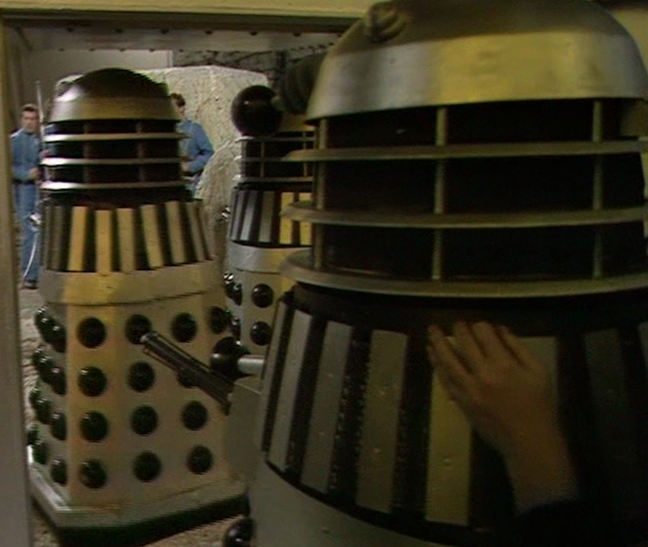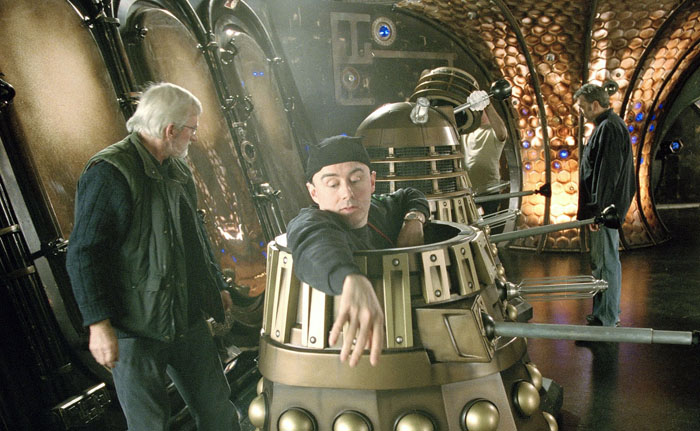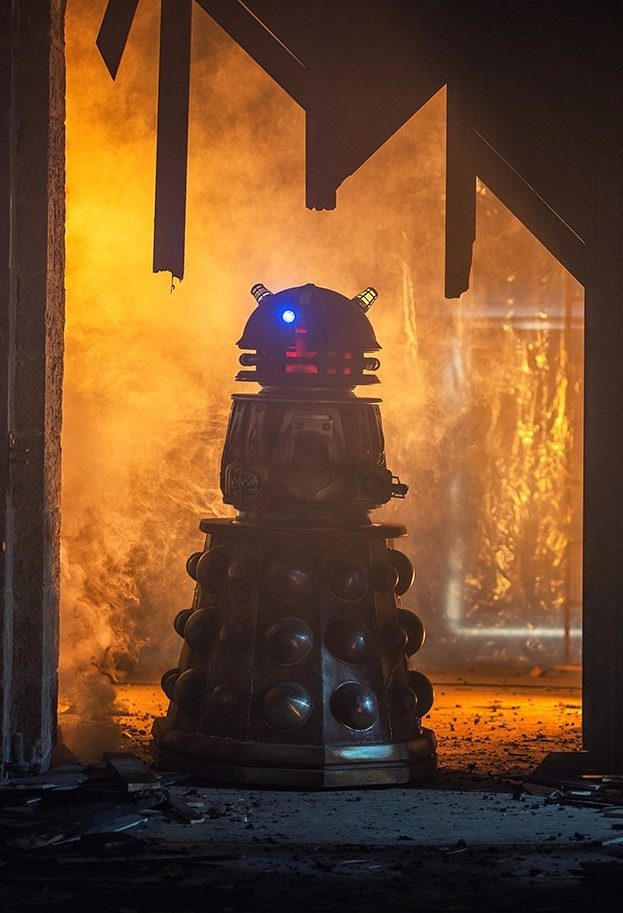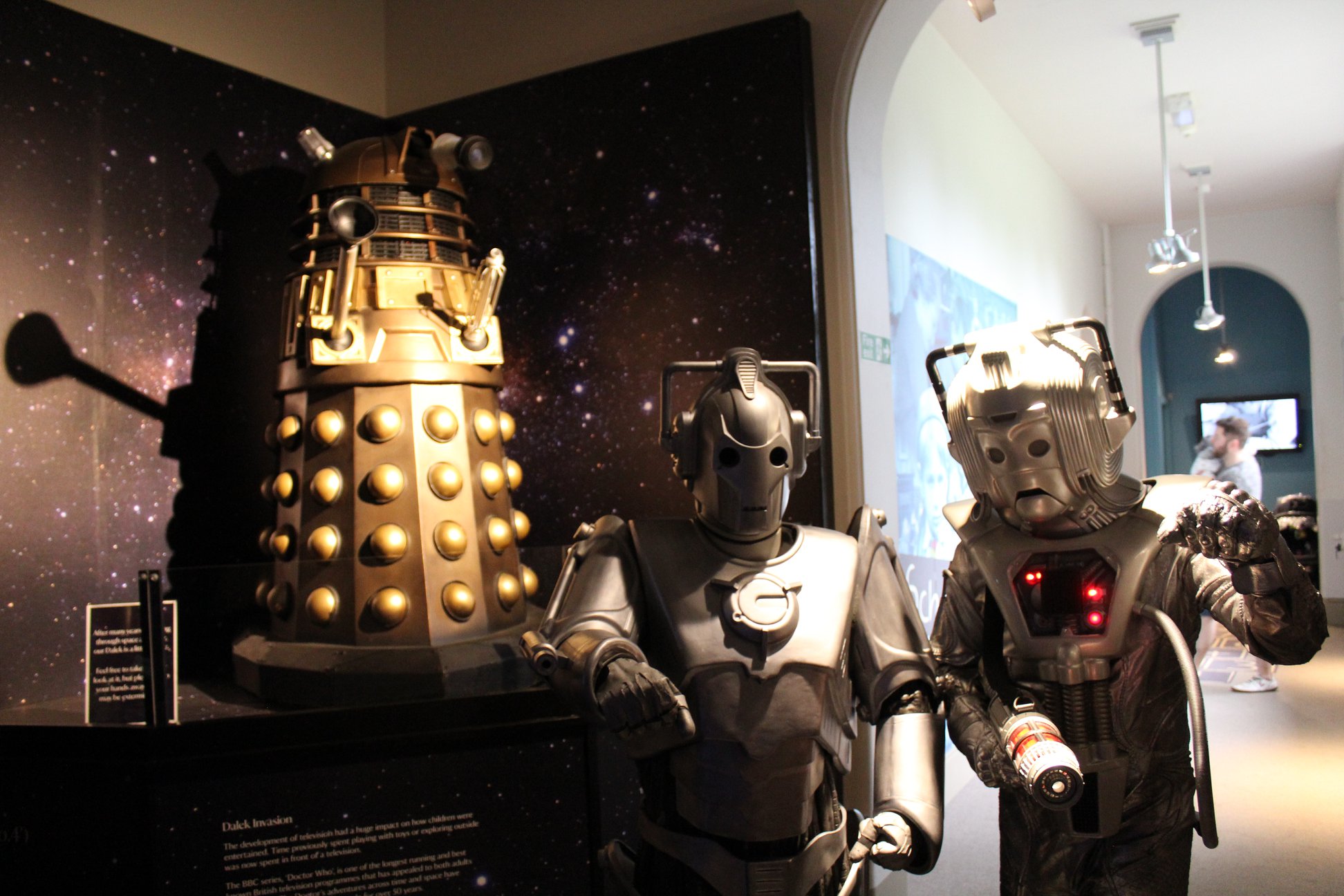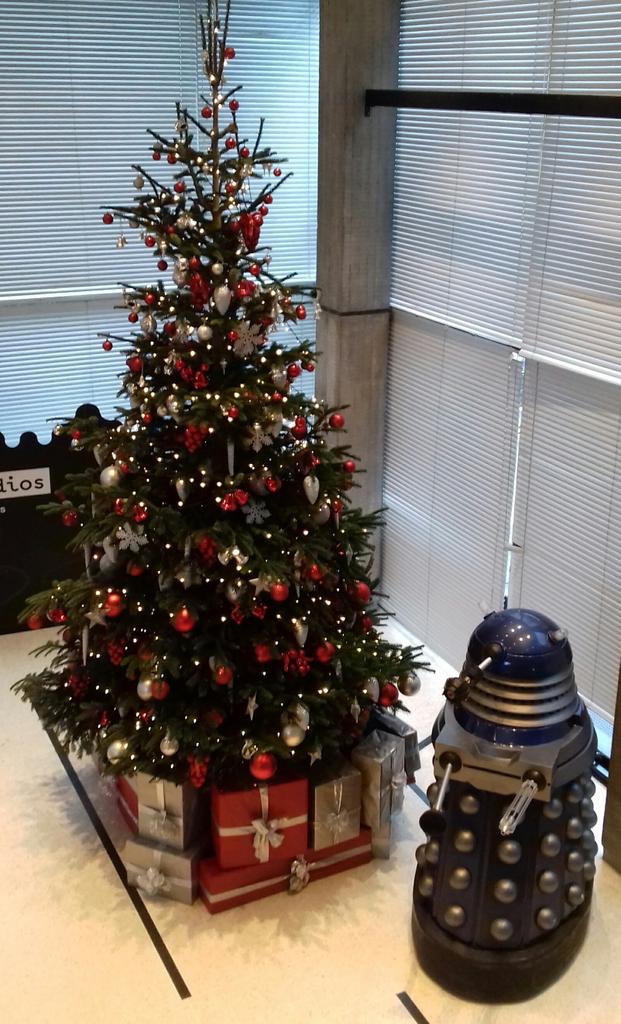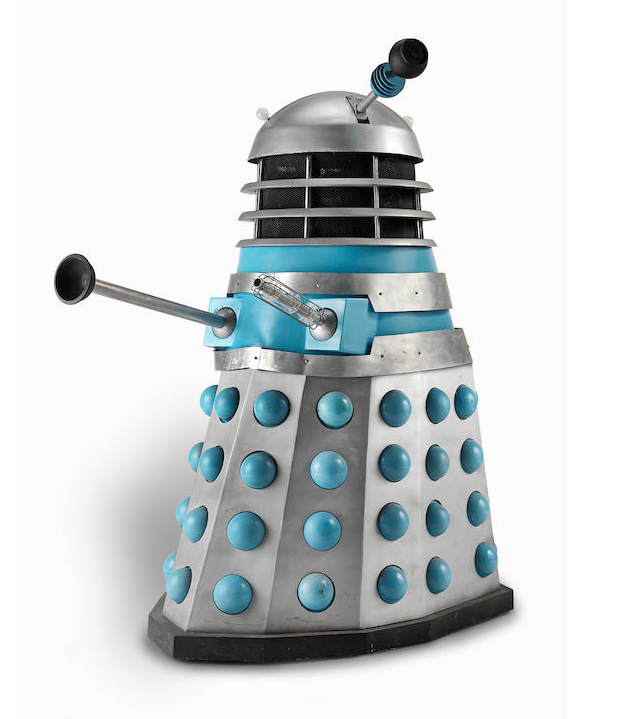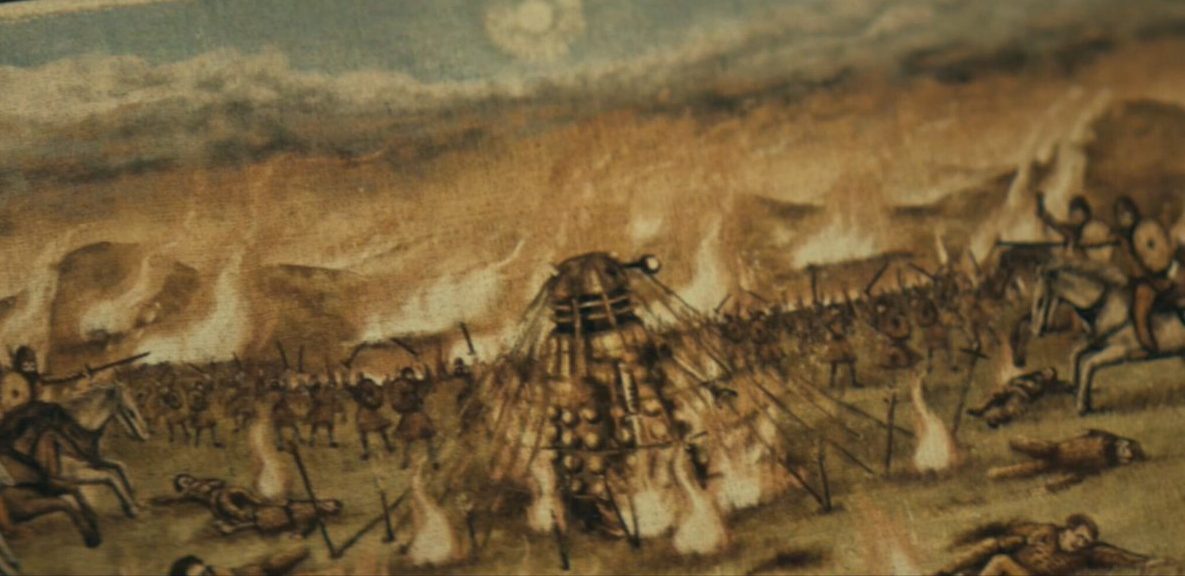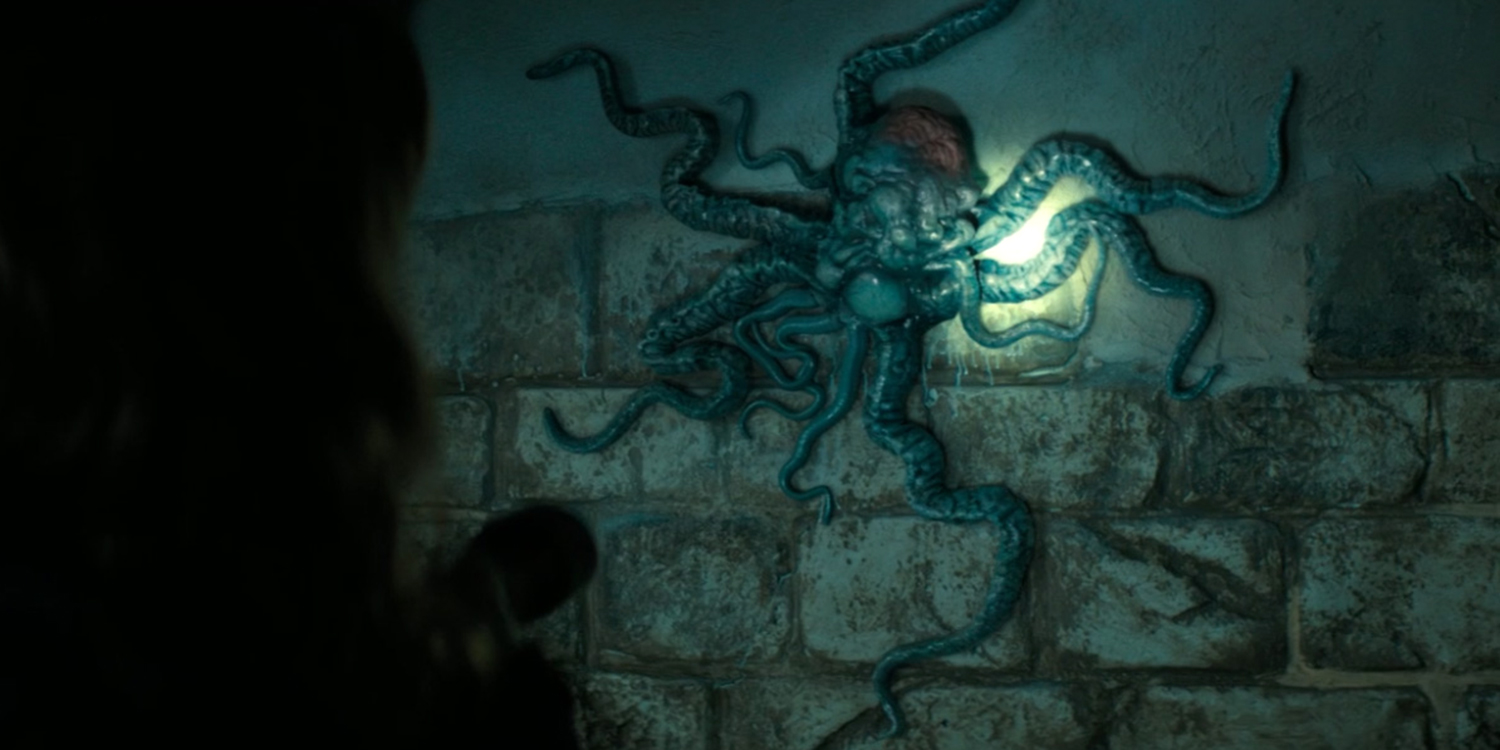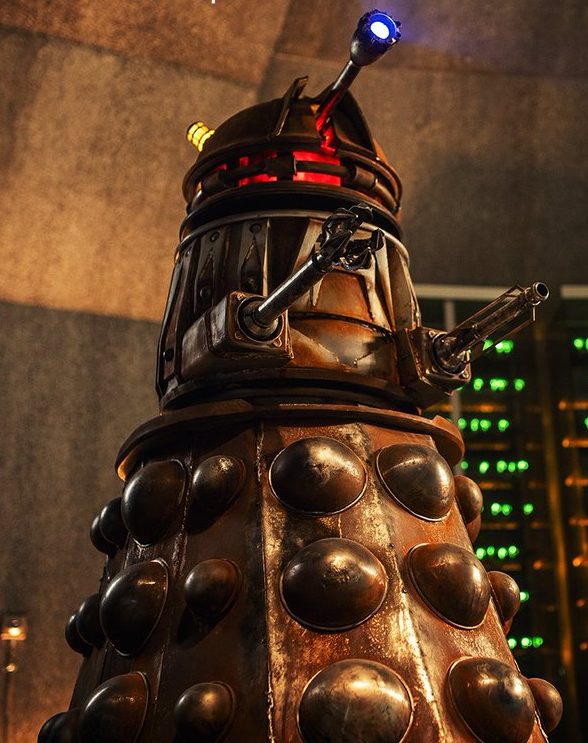Resolution
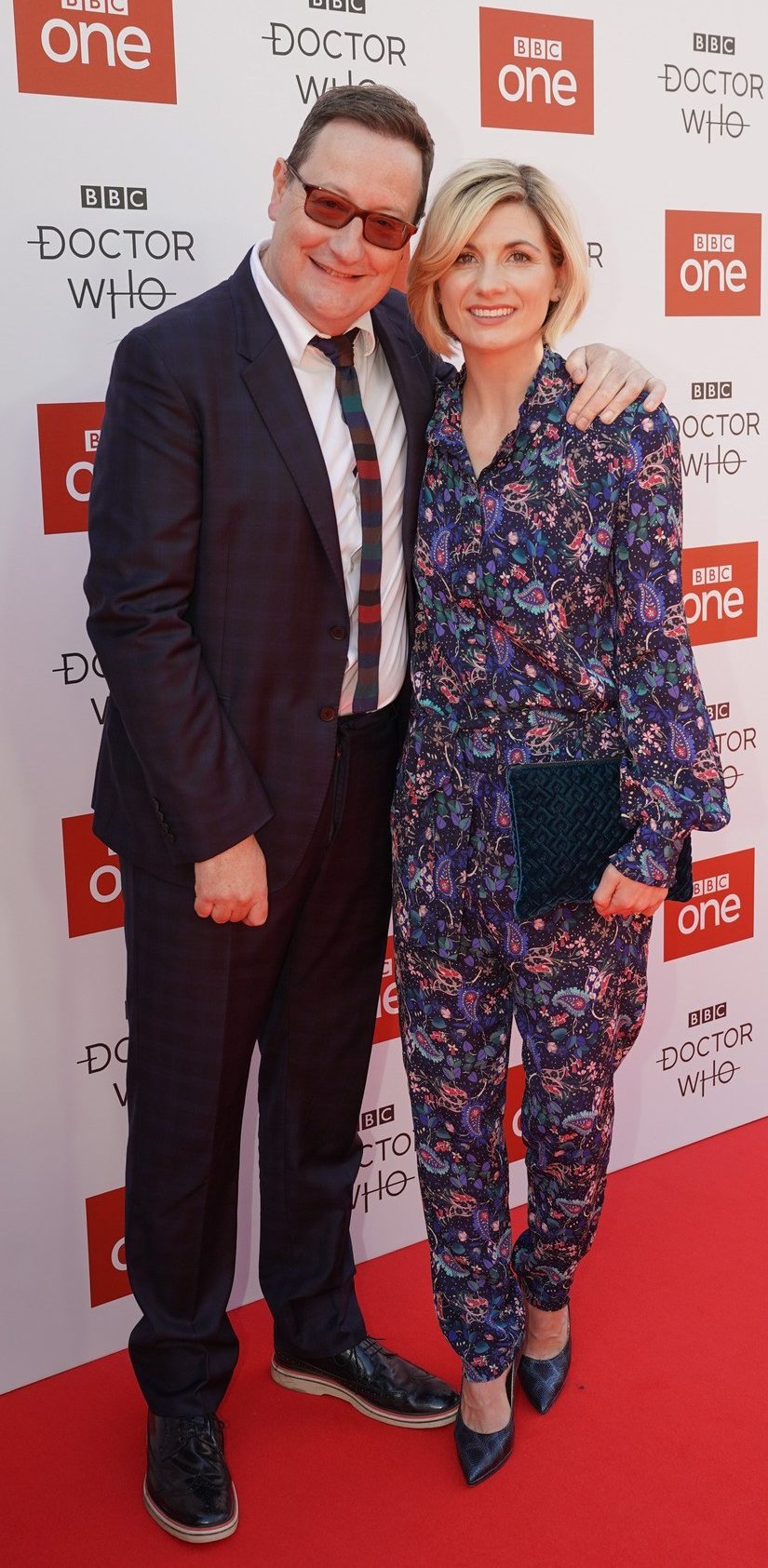
Chris Chibnall and Jodie Whittaker
Chris Chibnall was no stranger to Doctor Who when he took the mantle of showrunner from Steven Moffatt in 2017. Not only had he written several episodes for both Russell T Davies and Moffat in their time as heads of the show, he had also made an appearance on the BBC show Open Air in 1986 (as part of a group from The Doctor Who Appreciation Society) airing his views on the then current season – The Trial of a Time Lord.
He had received great acclaim for his murder mystery creation Broadchurch that aired on ITV (and starred David Tennant) so the BBC naturally felt he was the ideal choice to progress the show in the coming years.
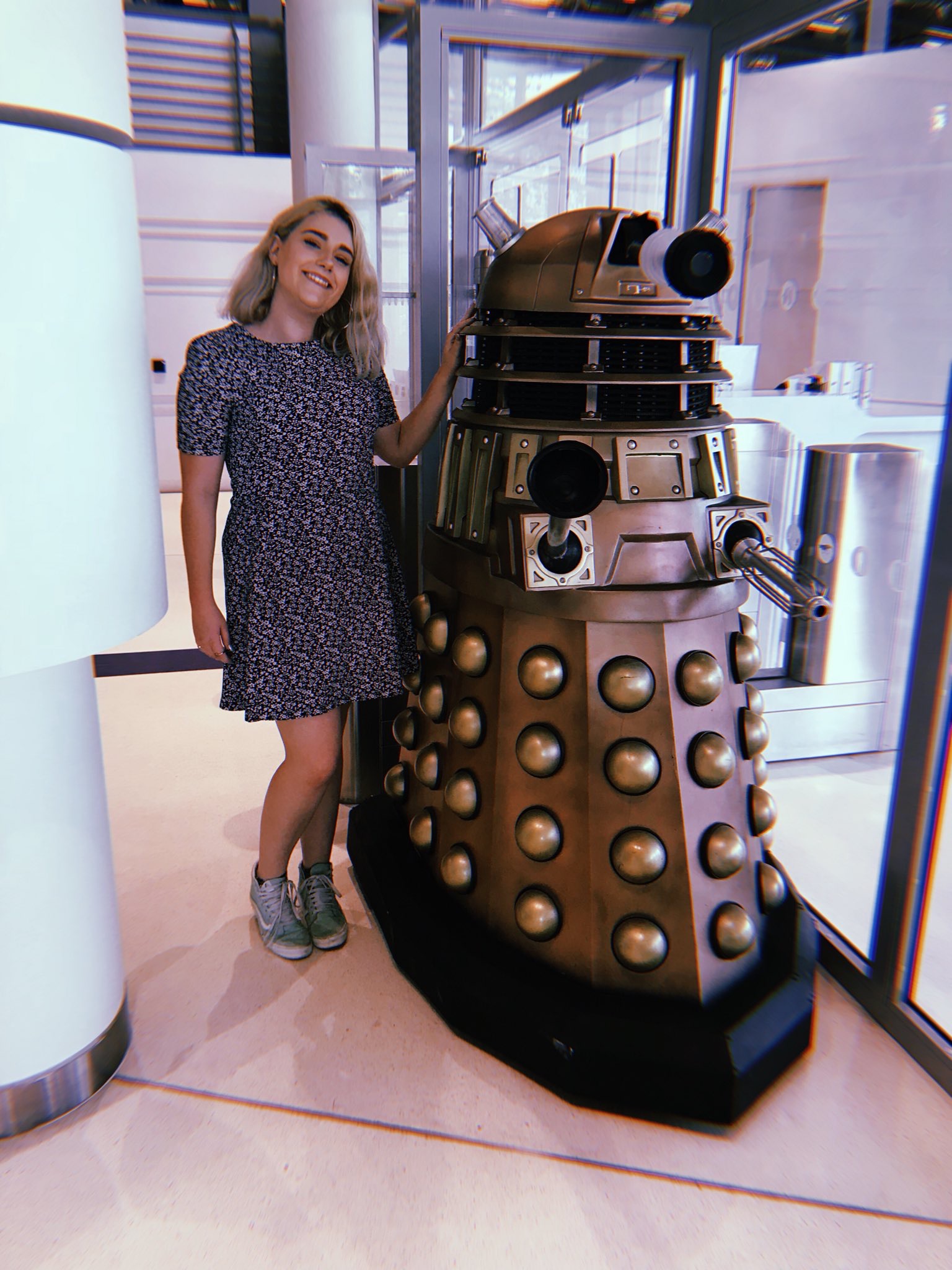
Beth Axford of “The Time Ladies” with Dalek TPE BBC-B at Television Centre. TPE BBC-B had appeared in Series Nine. Picture – Beth Axford. Click for a larger view.
His decision to cast Jodie Whittaker in the role of the role of the Doctor was just the first in series of brave decisions to shape his vision of the show for the future. He wanted a fresh start and the eleventh series to be a great jumping on point for new viewers of the show. Moffat had tried a ‘soft reboot’ for Series Five but Chibnall would take things even further.
Each of the Doctors since 2005 had faced the Daleks in their first season but this time there would be no ‘returning’ monsters at all and very few references to previous episodes. Even the new arrangement of the theme music was held back until the end of episode one and the TARDIS not seen until the climax of episode two. Despite that, he did conform to the tested formula for the first three episodes that worked well for both Russell T Davies and Steven Moffat for their first stories. Episode One was set in the present, episode two in the future and episode three in the past.
Despite the apparent absence onscreen, Dalek props were still to be seen out and about in promotional events. The NPD-A Supreme Dalek was spotted at the Hay Festival in Wales and the bronze Daleks could also be seen in their usual display spots at the BBC in London, Cardiff, Manchester and Birmingham.
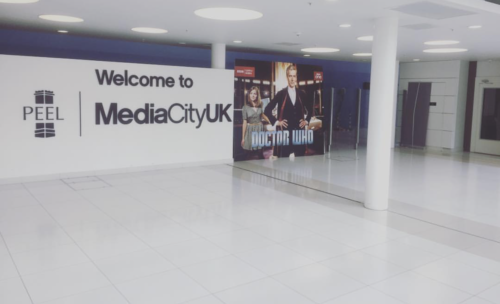
The Daleks dissapeared from Media City. Picture – tommytinker91
However, in May 2018 the two display props in Manchester, which included hero Dalek NSD5, seemed to vanish. Coincidentally, around the same time, preparation was underway for the annual festive episode of the latest series which would air a few weeks after the main series finished. Fans on social media and in the internet forums instantly put two and two together and speculated that the bronze Daleks were making a return to the show. As it transpired, they were only partially correct.
Sheffield Steel Dalek
Plans were in motion to bring back the Daleks in an episode entilitled Resolution but, in keeping with the ideals he had set out for Series Eleven, it wouldn’t be quite as they had been seen before, therefore allowing a new audience a ‘way into’ the Daleks.
For much of the story, rather than having the squid-like Kaled mutant occupying a hard, mechanical shell as normal, the living alien would occupy a squashy human one.
However, once its poor puppet person Lin (played by Charlotte Ritchie) had finished toiling away on Dinkle’s farm, a new casing emerged from the workshop. Being constructed partly from Earth technology and materials, it looked unlike any Dalek seen before. As described in the scripted dialogue it looked as if it had been “reconstructed from memory, and remnants.”
The concept designer for this revamped Dalek was Darren Fereday, who began working out rough ideas in his sketchbook before progressing to more developed concept art. He explained the process, “I was told by Production Designer Arwel Wyn Jones to look at hotrod vehicles that were rusty and chopped together. My initial designs were very different to what ended up on screen,” he says. “We went free reign to see what worked and what didn’t. Under Arwel’s direction I was steered in a particular direction. No-one wanted anything from the previous versions.” 1
Despite being based on an unconnected incident, rumours were now starting to fly around fandom so, to keep the project secret, his designs were referred to in correspondence as “Kevin”. The images of “Kevin” were delivered to Chris Chibnall and his colleagues in Cardiff. “Between the higher-ups, they discussed the sketches and the references,” explained Fereday.
One of those “higher-ups” was executive producer Matt Strevens, who explained, “This Dalek can exist outside of all the other Daleks. We’re not saying this is the beginning of a new race, so it’s very much a one-off Dalek in this environment.” 2
But they didn’t want to go too far, according to production designer Arwel Wyn Jones. “We wanted it to be the traditional silhouette. So that there was no doubt as to what we were seeing. But at the same time wanting to update it to feel like something quite scary still.”
“The main idea was to make it sleek and agile, being a scout it should be able to seem light and flighty but still feel extremely dangerous. The main thought for me was to get away from the bulk of the Dalek we have had so far.”
Once the art department and production team had assessed what they felt worked and what didn’t, the feedback was gathered up and given to Fereday to take it into 3D software. “I modelled various versions, doing a huge number of tweaks and changes.” He provided over 30 concept drawings in total, and the process of delivering concepts and reworking them based on feedback took several weeks, after which the new Dalek was finalised.
Overall, the shape was more symmetrical, slender and more conical than traditional Daleks. The new mid-section was cylindrical, with lots of raised plates to give it a reinforced, industrial feel. The gunboxes and slats retained similar detail to before but in a cruder, hand-built style. Instead of the traditional, flat, three neck rings, the upper stage was a torus of metal, behind which an extra red light source flashed when the Dalek spoke.
The build of the prop was handled by Lee Rashford and the Prop Makers and Art Department in Cardiff.
The Earthly nature of the Dalek in the story allowed them to take the unusual step of using real-world materials. Rather than the entirely fibreglass shell normally associated with the Daleks, there was metal employed which brought with it genuine rust.
The body of the prop was a steel frame, with parts made from different materials mounted onto it. Instead of manually crafting carious complex shapes, the crew used an increasingly common innovation: 3D printing. With the design have been finalised in 3D software, it allowed parts of the virtual model to be used to directly build the pieces. “I 3D printed a lot myself,” explains Fereday, “so it was a total team effort. Everyone touched every single part of it all.”
There are several rare instances of Daleks being moved without the usual operator inside in Doctor Who including Planet of the Daleks where a Dalek zooms out of the control room at high speed and another is wobbling unnaturally. In Death to the Daleks one is pushed as exits the saucer, and in Destiny of the Daleks one prop is shuffled towards to the camera behind Davros. These instances in which empty casings moved were unique exceptions in the series, up until the decision was taken to perform the prop in Resolution entirely without a human operator.
Colin Newman had worked on electronics in Doctor Who from 2005-2007 including helping to build and control the eye, dome and lights of the bronze Daleks for the first Daleks stories. He now returned over a decade later to bring his expertise to the Sheffield Steel Dalek (or SSD) which required multiple independent layers of robotics. As well as the head movement, the arm and gun now operated remotely. A feature introduced in 2005 and rarely seen since was that the entire shoulder section of the Dalek could rotate, allowing it to quickly fire at targets at the rear and the entire prop had to move without the benefit of leg power, requiring powerful motors in the fender of the skirt.
After it was delivered to set, secrecy remained paramount. Nikesh Patel, who played Mitch, was embarrassed to find that the subterfuge was a little too effective. When he arrived on set, he still only knew the baddie in the episode under the codename “Kevin”. Even Jodie Whittaker continued to refer to the antagonist as “Kev” during meetings and run-throughs, until eventually the co-star was told the true identity of the monster!

Nick Briggs with his ring modulator
The final design was, according to long-time Dalek voice artist Nick Briggs, “Lots of fun. Scrapheap Challenge, in a good way.” He told of how he changed the voice for the Kaled mutant when it was on the loose at the start of the story. “I knew the ‘internal’ voice of the Dalek should be very intense and close. I also thought it would sound different, because it wasn’t coming out of a speaker in the metal Dalek. This was the voice of its mind. So I got so close to the microphone.” 3
The mutant was achieved with a combination of CGI from the visual effects company Double Negative, and a practical prop created by a team which included Rob Allsopp.
Once the creature was inside its casing, Briggs changed his approach to the voice. He said it was, “Crueller, more expressive. I also wanted to make this one super-arrogant. It’s been bottling all this rage up for hundreds of years.”
When the Doctor and her friends successfully attach a gadget to the casing which melts the Dalek, a second version of the shell was built which was torn open and damaged. Surprisingly, the red-hot molten metal edges of the dead Dalek were achieved with practical LED lighting rather than in post-production.
The cast and crew were delighted with the final version of the welded Dalek. “You get that sense that it’s been built here,” said Whittaker, “and it’s collected all these materials to reform itself. It feels steeped in history, but brand new.”
Fereday reflects on the scale of the achievement of himself and the team. “We redesigned every aspect,” he observes. “We changed everything. It was a huge honour to help bring a new Dalek to life.”
Filming wrapped on 3rd August and the crew faced the task of keeping the Dalek as a surprise until Christmas.
Trust A Dalek?
Whilst one new Dalek prop was finishing its first adventure in front of the cameras, another, older, hero prop was finding a new home to rest. Bronze Dalek NSD4 had been auctioned in June 2016 at Bonhams and retailers, The Who Shop, bought the Dalek but because of its tricky ‘one piece’ construction (and therefore size) they reluctantly sold the prop to Sudbury Hall in Derbyshire. The hall is owned by The National Trust and they had received a lottery grant to enable them to purchase the Dalek.
Mike Tucker at The Model Unit gave the prop some light restoration and delivered it to the hall in late August. The official unveiling of the Dalek took place in October and featured as part of their ‘Museum of Childhood.’
New Year’s Resolution
Despite the best efforts of the crew, rumours about the Daleks return were spreading in the run up to Christmas and seemed to be confirmed after a press showing two weeks before its eventual transmission day of 1st January 2019.
Before reaching that date though, another of the older Dalek props was about to find a new home. The prop in question was Dalek AB2 which was owned by Andrew Beech. It had received two early TV appearances – Summer Scene in 1992 and The Generation Game in 2000 before going on to feature at The Doctor Who Experience and eventually making official Doctor Who appearances in Series Seven and Series Nine.
It came up for auction at Bonhams on 11th December and fetched £15,625 including premium. Its ‘partner’ – Dalek AB1 had been auctioned in December 2017.
With the transmission day of Resolution finally arriving, viewers got their first look at the new Dalek prop. The plot of the tale reveals that the first Daleks ever to leave Skaro were the Recon Scouts, which were sophisticated units with capabilities beyond the normal Dalek soldier. However, the appearance of this type of casing is shrouded in some mystery because its original form was only ever seen in a centuries old painting of a battle where the Dalek is defeated.
At first glance the painting appears to suggest its a standard bronze drone casing. However, on closer inspection, there are some differences. The eye appears to have a white light rather than blue with no discs on the stalk, the gun and arm are reversed and the scale of the Dalek seems much larger when compared to the human figures close by.
Its unclear as to whether the BBC artist was asked to put himself in the shoes of a 9th century artist painting the scene from memory or the details of the Dalek are an informed design choice.
The SSDs mission was designated reconnaissance and conquest, and the Doctor supposes that these units were the first to reach Earth. In the 9th century, a combined force of Earth warriors managed to defeat the Dalek, and they burned its casing. For an unknown reason, they didn’t burn the creature within but instead chopped it into three pieces, and buried two on Anuta Island, South Pacific and Siberia, Russia. The third piece was intercepted in Yorkshire, England where its courier was killed by bandits on a hillside road. The corpse lay undisturbed on the road long enough to become buried over time, and the hillside later became the sewers beneath Sheffield town hall.
After hundreds of years’ burial, UV light brought a third of the creature back to life. The creature possessed an inherent teleportation capability, and was able to transport its South Pacific and Siberian body-parts across Earth to reunify itself. A very useful skill but perhaps not one that can be used frequently, as the the creature doesn’t perform this trick a second time.
The only known section of the original casing is its gun, which had a set of fins not seen on any previous design. Presumably this was salvaged from the funeral pyre and kept secretly over the centuries before being bought up by MDZ Research and later recovered by the mutant. This along with unspecified other sections was built into a new casting which was completed using Earth metals.
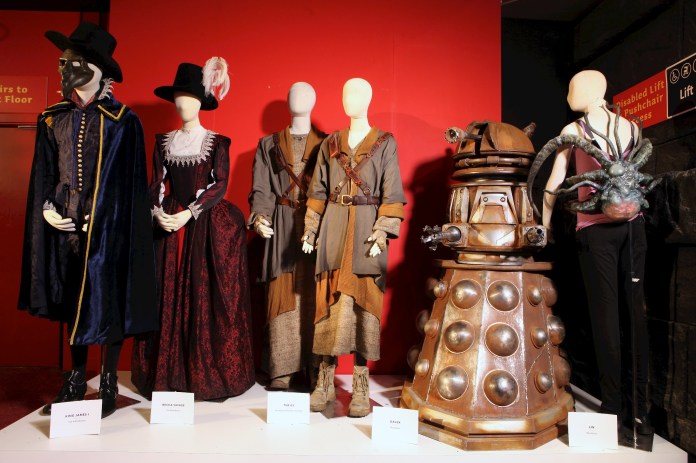
The SSD and mutant on display at Madame Tussauds in Blackpool. Picture – Jason Lock. Click for a larger view.
Given the unusual design of the shell which the Dalek constructs itself, it’s reasonable to suppose that the true casing for the Recon Scout has some of these elements, such a three skirt hemispheres, but it likely also has some features associated with the familiar bronze Daleks, such as the channels in the shoulder slats.
This latest attempt ‘to do Daleks differently’ was generally greeted with positive reviews and many felt it was one of the stronger stories of the eleventh series. At Easter 2019, the SSD prop and the pratical mutant joined a waxwork display of Jodie Whittaker (with her new TARDIS prop) at Madame Tussauds in Blackpool.
Daleks are, as Jodie Whittaker put it, “the one thing everyone associates with the show.” And she was delighted to see them back in the 2019 new year’s day special, Resolution. “For that to be in my first season is really exciting.”2
-
Interview with Gavin Rymill for the Eaglemoss Figurine Collection
-
BBC Youtube Channel
-
Doctor Who.TV
